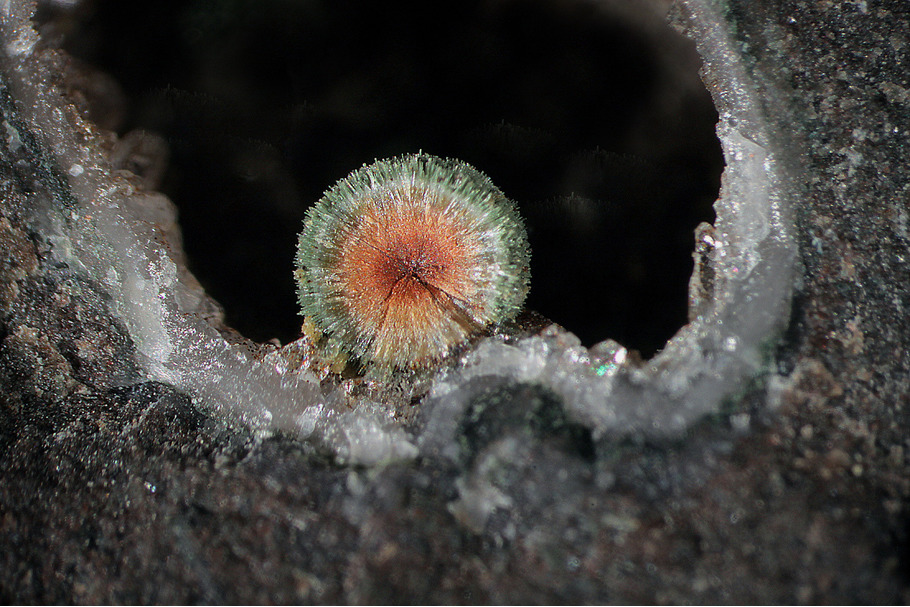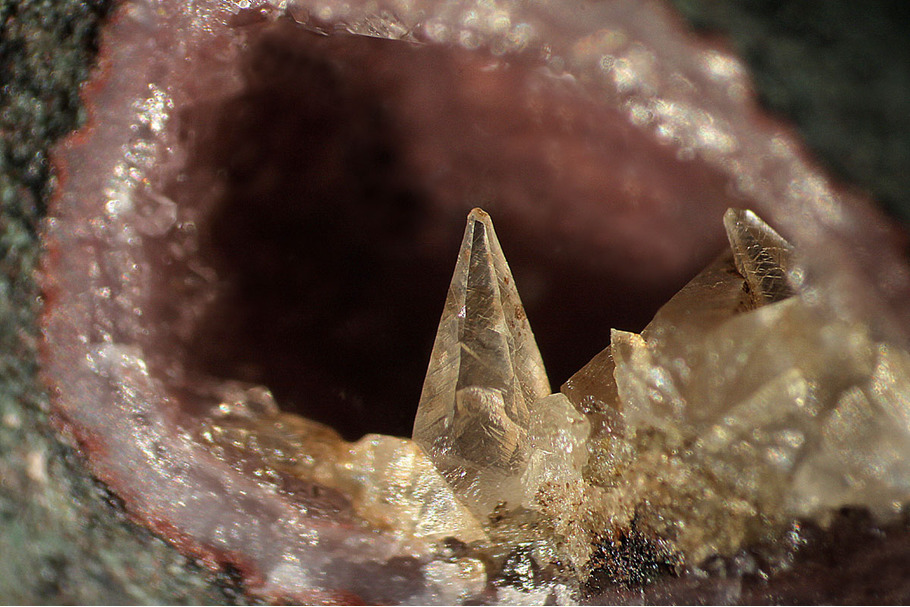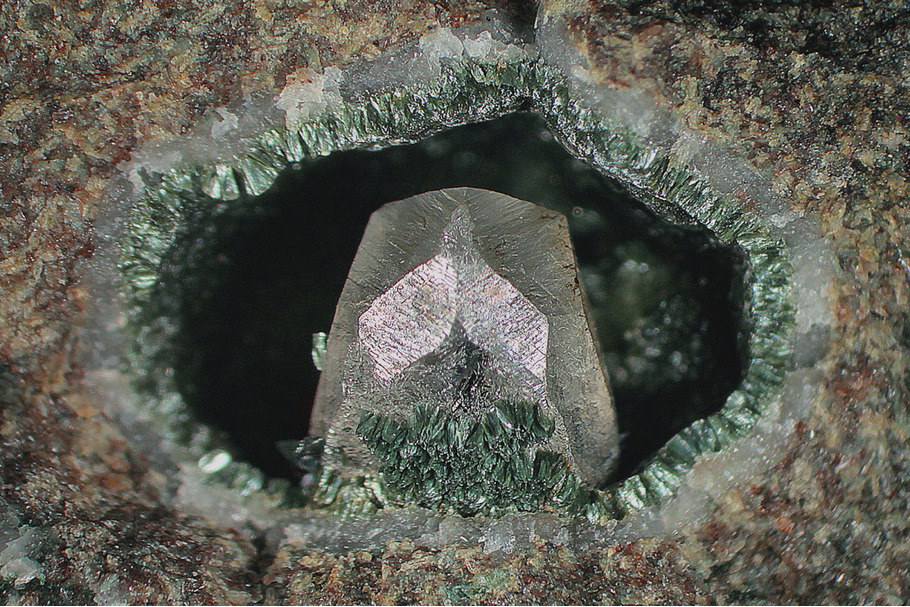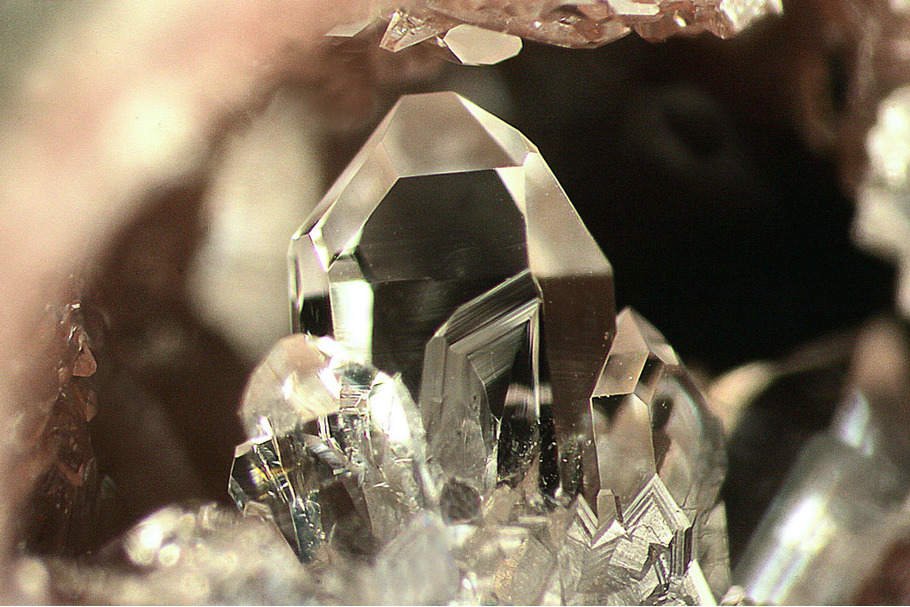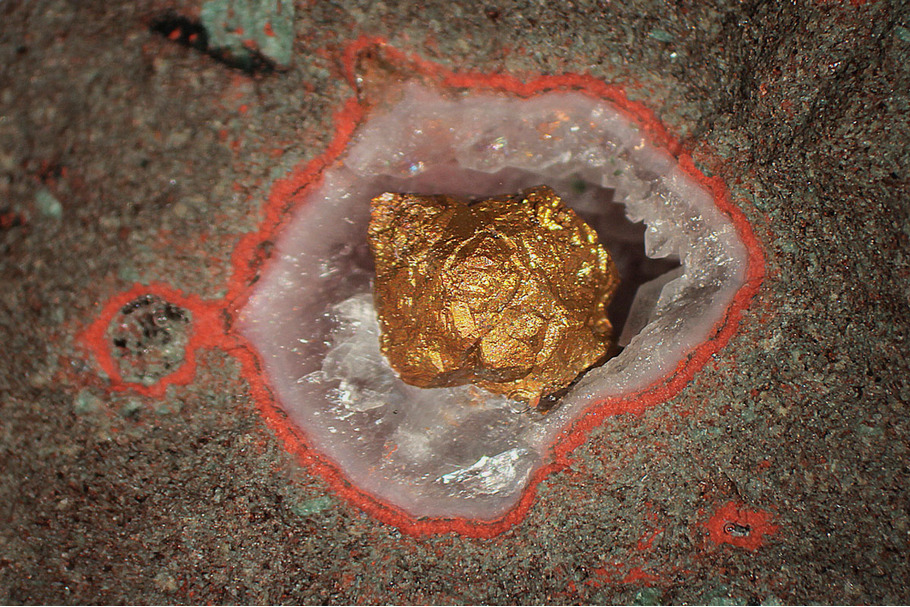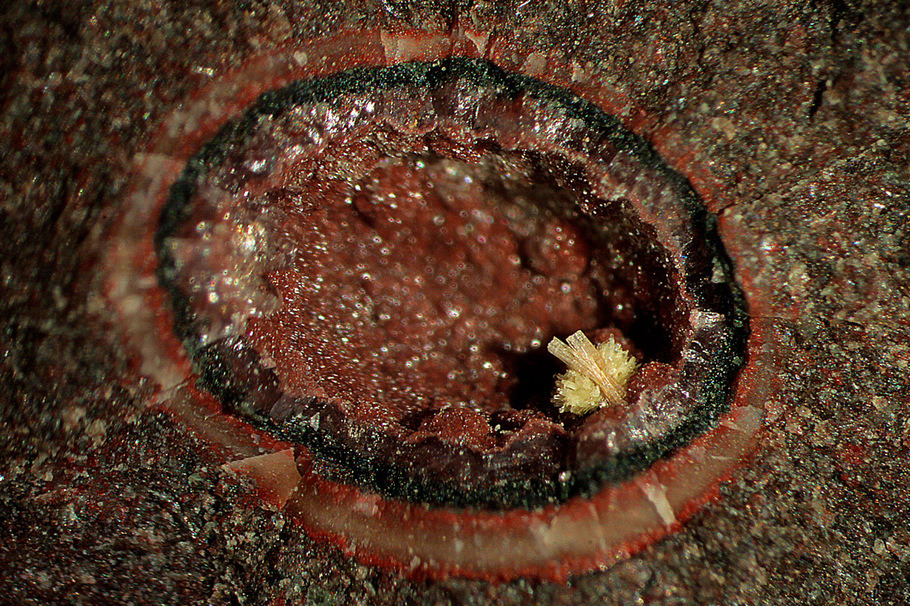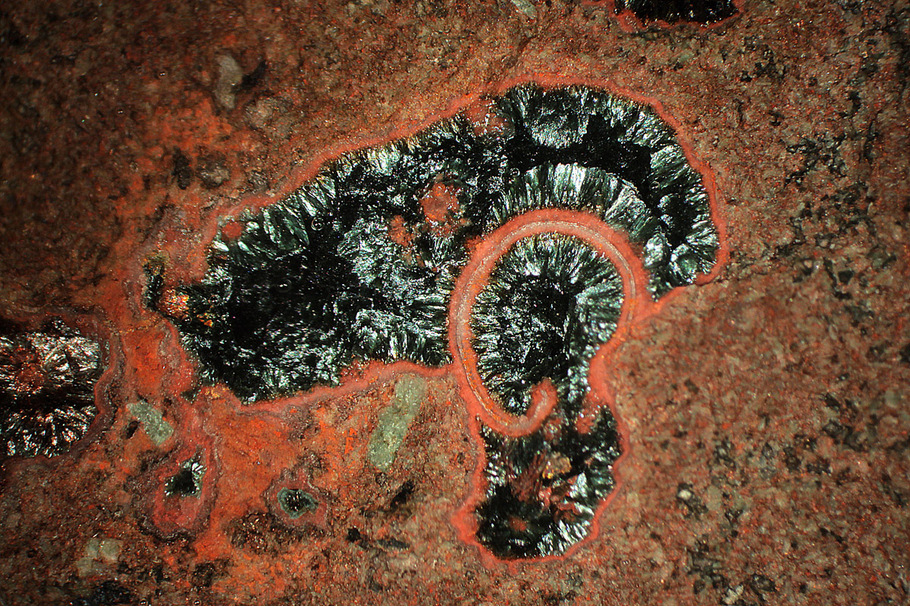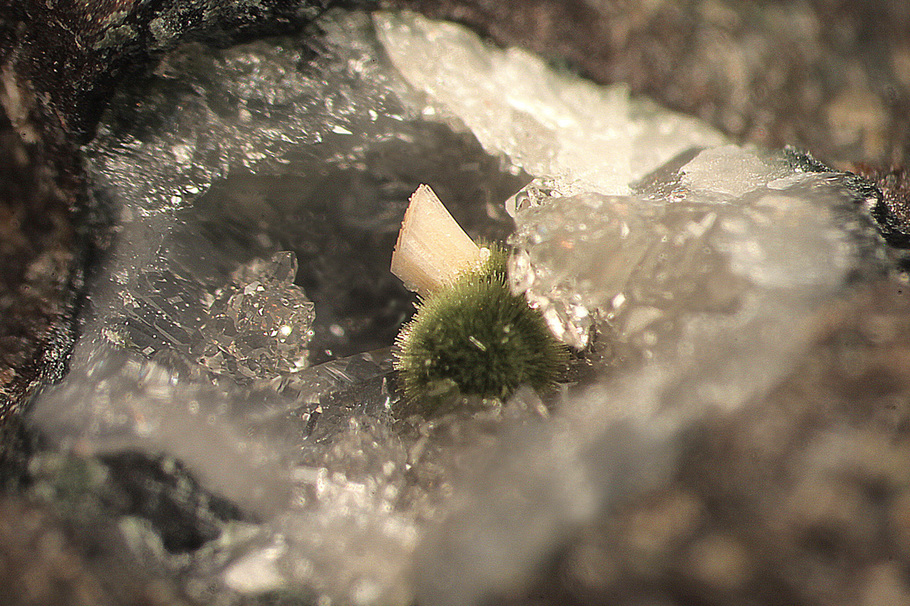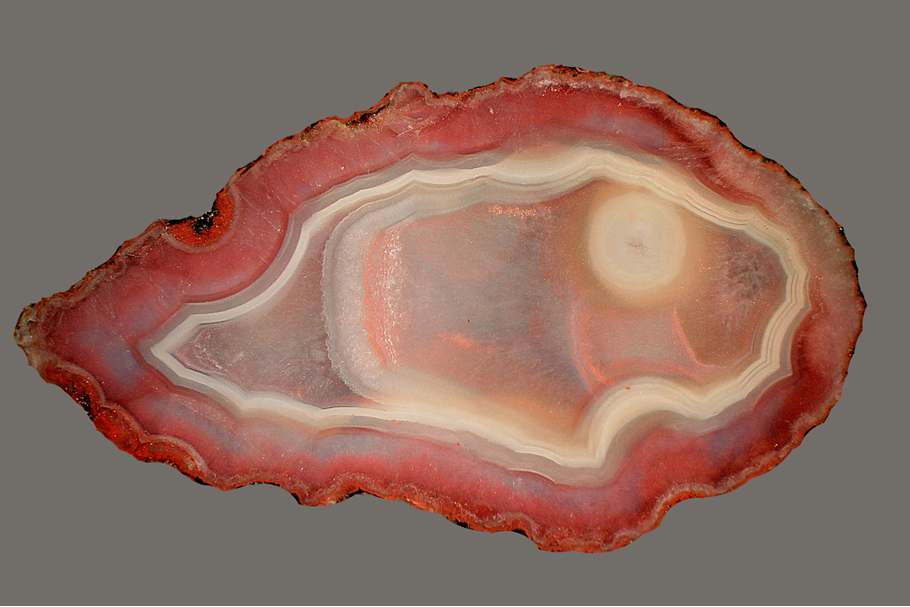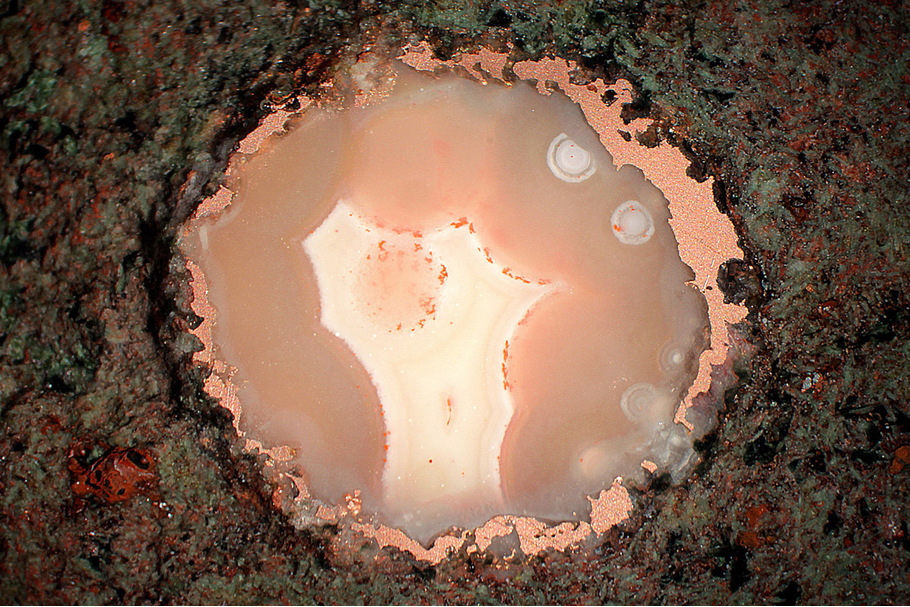St. Louis Mine, Houghton Co. Michigan
Last Updated: 9th Sep 2020By Larry Maltby
Introduction
The St. Louis Mine was an exploratory shaft sunk into the Copper City Flow following a brown, iron rich basaltic flow top that showed traces of copper in the amygdules.
The Copper City Flow is unique for several reasons. At this location, prior to the tipping of the strata due to the Grenville Orogeny, it was one of the deepest and therefore one of the earliest basaltic flows of the Portage Lake Volcanics lying just above the Keweenaw Fault. Its basalts have been subjected to many pulses of hydrothermal mineralization and alteration resulting in some unique mineral assemblages within the vesicles found in the flow tops. During the past four years (2010 thru 2013) we have collected hundreds of specimens and spent many hours studying and photographing them to provide the preliminary documentation presented here.
The source of most of the specimens is the rock piles at the old St. Louis Mine site. The St. Louis sunk the only shaft that penetrated the Copper City Flow. Due to low returns of copper, work at mine was short lived resulting in a relatively small amount of available material. The basalts show considerable variation in color and crystal structure, this along with other rock types found on the dumps, indicates a complex geology.
The minerals found here are very interesting but they are microscopic in size. It would be very rare to find a well crystalized specimen suitable for display without magnification. During our search we became interested in the abundant micro agates not only because of their colorful beauty, but because of their inclusions of secondary minerals. In this respect they are unique to anything that we have previously observed in the Michigan Copper Range.
Copper is found in some of the amygdules as complex free standing crystal aggregates within open areas. It is also frequently found as inclusions within the agates. Quartz is the most abundant mineral found in the amygdules both as micro crystalline agate and, as well formed free standing crystals. Pumpellyite, a mineral common in many of the mines in the Copper Range, is found here in a wide variety of color and form. Spherical crystal aggregates are common, many of them showing alteration by iron compounds. The pink agate rims with pumpellyite “green stone” centers are truly unique. There is also a bright yellow variety of pumpellyite that preliminary analysis indicates is most likely pumpellyite Fe2.
Data is almost nonexistent on the Copper City Flow. We have been unable to find any professional papers on this subject. The material that is presented here is introductory in nature in the hope that future mineralogists will continue the study and provide the lab work needed to answer some of the many questions regarding this deposit.
The Copper City Flow is unique for several reasons. At this location, prior to the tipping of the strata due to the Grenville Orogeny, it was one of the deepest and therefore one of the earliest basaltic flows of the Portage Lake Volcanics lying just above the Keweenaw Fault. Its basalts have been subjected to many pulses of hydrothermal mineralization and alteration resulting in some unique mineral assemblages within the vesicles found in the flow tops. During the past four years (2010 thru 2013) we have collected hundreds of specimens and spent many hours studying and photographing them to provide the preliminary documentation presented here.
The source of most of the specimens is the rock piles at the old St. Louis Mine site. The St. Louis sunk the only shaft that penetrated the Copper City Flow. Due to low returns of copper, work at mine was short lived resulting in a relatively small amount of available material. The basalts show considerable variation in color and crystal structure, this along with other rock types found on the dumps, indicates a complex geology.
The minerals found here are very interesting but they are microscopic in size. It would be very rare to find a well crystalized specimen suitable for display without magnification. During our search we became interested in the abundant micro agates not only because of their colorful beauty, but because of their inclusions of secondary minerals. In this respect they are unique to anything that we have previously observed in the Michigan Copper Range.
Copper is found in some of the amygdules as complex free standing crystal aggregates within open areas. It is also frequently found as inclusions within the agates. Quartz is the most abundant mineral found in the amygdules both as micro crystalline agate and, as well formed free standing crystals. Pumpellyite, a mineral common in many of the mines in the Copper Range, is found here in a wide variety of color and form. Spherical crystal aggregates are common, many of them showing alteration by iron compounds. The pink agate rims with pumpellyite “green stone” centers are truly unique. There is also a bright yellow variety of pumpellyite that preliminary analysis indicates is most likely pumpellyite Fe2.
Data is almost nonexistent on the Copper City Flow. We have been unable to find any professional papers on this subject. The material that is presented here is introductory in nature in the hope that future mineralogists will continue the study and provide the lab work needed to answer some of the many questions regarding this deposit.
History and Geology

Longitudinal Stratigraphic Section of the Portage Lake Volcanics on the Keweenaw Peninsula showing the stratigraphic relationship of five of the named basaltic flows. The illustration is modified from the USGS professional paper 754-c.
Currently the best reference for the geology, history and mineralogy of the St. Louis Mine is the article in the September/October 2013 issue of the Rocks and Minerals magazine written by Tom Rosemeyer. Tom is an impeccable researcher with an extensive library covering the Michigan Copper Range and he also has access to the archives at Michigan Technical University.
After graduation from Michigan Tech in the mid 1960’s, Tom worked as a mining engineer at the Kingston Mine near Calumet, Michigan. Later he worked at the Camp Bird Mine near Ouray, Colorado. After thirty years at the Camp Bird, Tom retired and returned to the Keweenaw where he has written extensively about the Copper Country.
Below is a brief sketch of both the history and geology of the St. Louis Mine.
_History_
In the early days of frenzied prospecting on Michigan’s Keweenaw Peninsula traces of copper were found in the amygdaloidal top of the Copper City Flow just east of the present location of Calumet, Michigan. The amount of copper was skimpy and it wasn’t until 1853 that a promoter, C. C. Douglass, raised some funds to do some exploratory surface work. The results were not promising and the property languished going through a series of new owners including the St. Louis Copper Company. In 1898 the Calumet and Hecla Mining Company acquired the rights to the workings and in 1910 did some drilling to better define the load. In 1911 work on a shaft was started and continued until 1913 when the Michigan Copper Miners’ strike caused all work to cease.
No significant production of copper was achieved during this time and the mine was never reopened.
_Geology_
The illustration to the right tells a simplified story of the geology of this area. It shows the relative position of five of the major basaltic flows in the Portage Lake Volcanics. The complete geological column of the Portage Lake Volcanics contains about 200 Basaltic flows interbedded with massive deposits of conglomerates and occasional layers of sandstone. The entire thickness of the formation was built up over the Mid Continental Rift by a repeating cycle: The erosion of the surrounding highlands, the aluvial deposition of gravel, cobbles and sand, the volcanic eruption of flood basalts and subsidence over the rift.
The Copper City flow being near the bottom of this column was subjected to repeated volcanic activity including the major hydrothermal event that deposited copper throughout the Portage Lake Volcanics. Hydrothermal pulses are the likely cause of the alterations seen on the mine dumps and in the specimens shown here.
Minerals
___Pumpellyite___This location is one of the most interesting for the study of pumpellyite. It occurs here in a great variety of colors, forms and associations.
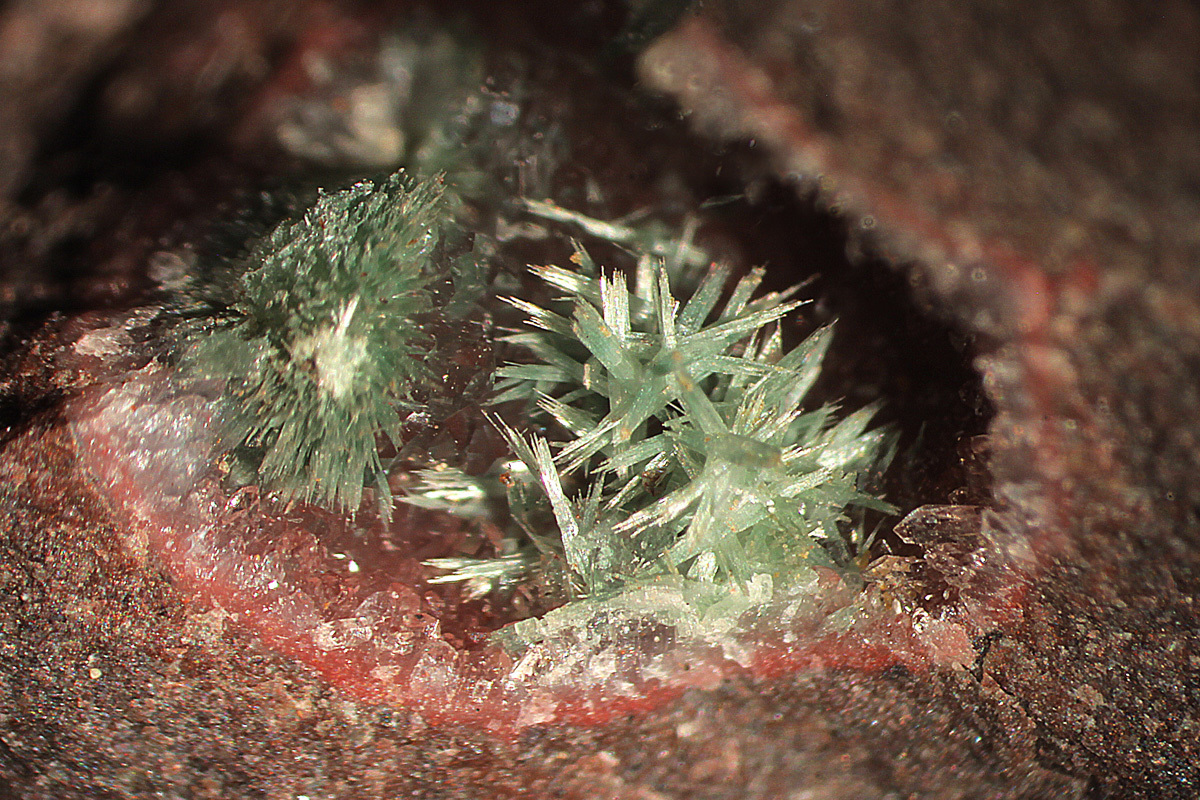
Pumpellyite (FOV 5.2 mm). The pale green, jackstraw crystals of pumpellyite are very common throughout the Michigan Copper Range. This specimen was found at the St. Louis Mine. However, the radial spheres shown below are much more common at this location.

Pumpellyite (FOV 3.5 mm). These are the typical radial clusters commonly found at this location. They are perched on pink quartz crystals in the center of a vesicle. Some of the quartz has copper inclusions.
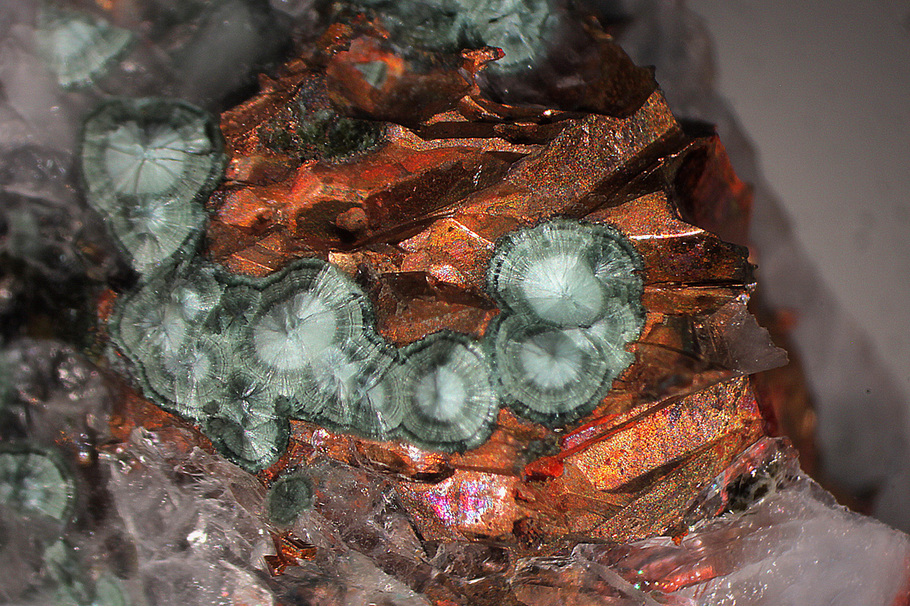
Pumpellyite on copper (FOV 5.0 mm) showing distinct color zoning.
The exposed copper face is covered with quartz crystal casts.
The exposed copper face is covered with quartz crystal casts.

Pumpellyite on quartz with saponite (FOV 4.5 mm). The saponite appears as soft clumps adhering to the tips of the pumpellyite crystals.

Pumpellyite (FOV 4.5 mm) showing a first generation of yellow pumpellyite and a second generation of blue green pumpellyite.

Pumpellyite (FOV 9.0 mm) also showing two generations, a central core of yellow, followed by green acicular crystals.
Pumpellyite that is composed of compact radial clusters in various shades of green in a “turtle back” pattern has been given the varietal name chlorastrolite. It has been known for years as “Isle Royal Greenstone” or just “Greenstone”. It is often cut and polished and used in jewelry and has been designated as the Michigan State Gemstone. It occurs on Isle Royal and at several locations on the Keweenaw Peninsula. The Central and Phoenix mines are known to have produced Greenstone.
At the St. Louis Mine it sometimes fills the center of very small agates resulting in the beautiful specimens shown here. We don’t know of any other occurrence like this in the Michigan Copper Range.
>

Pumpellyite (FOV 3.6 mm) showing significant alteration at the tips of the crystals. Photographed submerged in distilled water.

Pumpellyite (FOV 3.6 mm) St. Louis Mine Exploration, Laurium, Houghton Co. Michigan. Photographed dry.
___Yellow Pumpellyite___Yellow pumpellyite is a rare color phase. The St. Louis Mine is the most likely location in the Keweenaw to acquire specimens. We did find one specimen of yellow pumpellyite at the Wolverine No. 2 Mine. Several of these specimens have been analysed.

Pumpellyite (FOV 3.2 mm). The yellow "turtle back" pumpellyite superimposed on the more typical blue green is unique.
___Calcite___
___Quartz___Many of the vesicles found here contain an unusual form of quartz. The typical quartz prisms are “laying down” parallel to the wall of the vesicle. The crystals follow the curvature around the vesicle rather than standing upright pointing toward the center.

Quartz crystals in a vesicle (FOV 13.0 mm). Quartz filled vesicles like this are common at the St. Louis. Many of the vesicles show the quartz crystals laying parallel to the sides of the vesicle rather than pointing straight inward to the center. We have started referring to this feature as "lay down quartz".
___Hematite___

Basalt slab (7.0 X 5.7 cm) showing the locations of hematite crystallization.
St. Louis Mine, Laurium, Houghton Co. Michigan
St. Louis Mine, Laurium, Houghton Co. Michigan

The large agate (1.3 cm) in the slab shown above has copper inclusions along a fracture line and a hematite crystal at the lower right edge. (See detail, right)

Figure 1. (FOV 4.5 mm) A hematite crystal attached directly to he wall of the vesicle under the chlorite and agate bands indicating a first generation crystal.

Figure 2 (FOV 3.0 mm) A hematite crystal cluster that formed after the agate rim indicating a later, second generation crystallization

Figure 3 (FOV 2.5 mm) A hematite crystal cluster perched on the macro quartz crystals in the open space at the center of another amygdule. A possible third generation crystallization.
___Copper___

Copper (8.0 mm) in a quartz vesicle shown with the altered basalt matrix. (Photographed submerged in distilled water)

Copper (FOV 10.5 mm). This a very interesting slotted crystal showing some oxidation. There is some consensus that the green clusters are pumpellyite. (analysis pending).

Copper and pumpellyite (FOV 5.2 mm). A closer view of the green clusters associated with the copper.
___Epidote___Yellow epidote is well known from other locations, however, the epidote found here is especially bright. This has also been verified with analysis.

Epidote with exceptional yellow color (FOV 4.5 mm) confirmed as epidote at the New Mexico Bureau of Geology and Mineral Resources.

Epidote (FOV 4.5 mm). This specimen was analysed at the New Mexico Bureau of Geology and Mineral Resources and confirmed to be epidote.
___Chlorite Group___
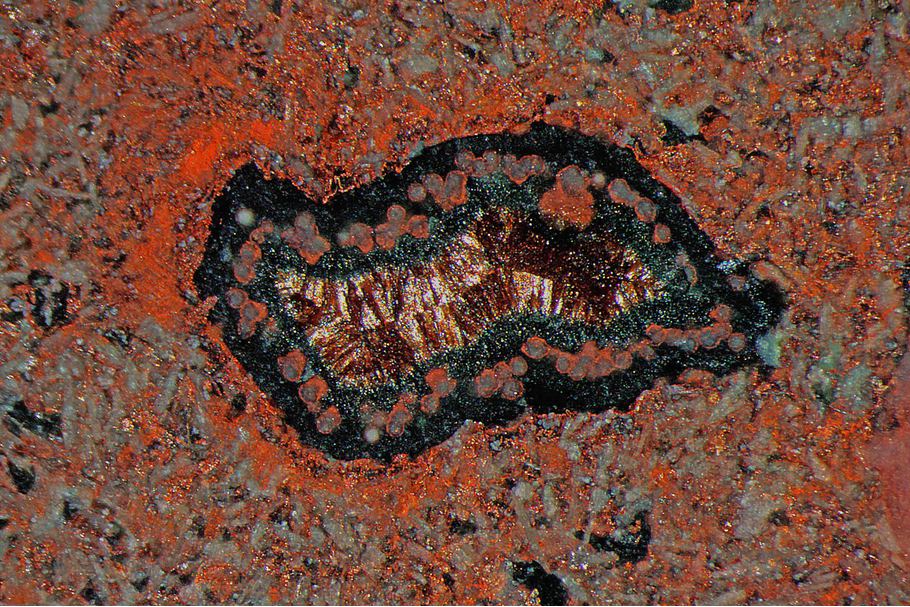
Chlorite with hematite spheres (FOV 3.2 mm). The micaceous black to dark green chlorite changes abruptly to a light bronze color at the center.
___Laumontite___
___Microcline___Microcline is rare at the St. Louis. The specimen below with copper inclusions is unique.

Microcline crystal (2.2 X 1.3 mm) with copper inclusions. Also shown are white and green pumpellyite clusters and green "globs" of saponite.
Agates
You will notice that most of the agates shown below are very small. Preparing them for photography required some unique methods. They are nearly all found in slabs of basalt that have been lapped with silicon carbide grits on a cast iron lap. This provided a means to hold them during the process. They were lapped to at least 600 grit size and then photographed submerged in water. None of them were polished. After photography, some of them were removed from the matrix using photo shop elements to eliminate the distraction of the “busy” back ground crystal textures. Others were shown in the matrix for the interest that that would provide.

Agate (FOV 16.0 mm) showing the complete distorted amygdule indicating movement of the lava during solidification.
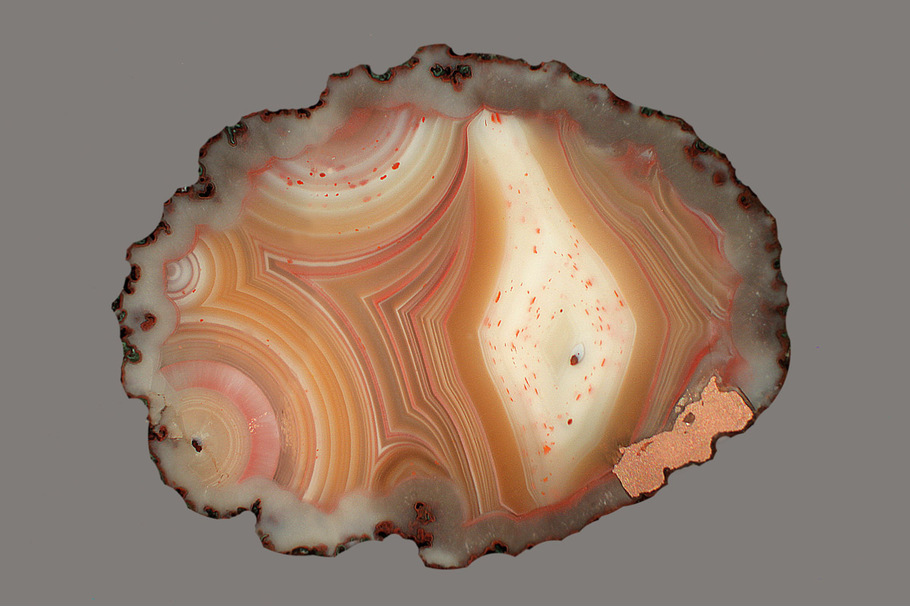
Agate (1.3 cm) This one looks a lot like a laguna agate except the copper block in the rim points to the Michigan Copper Country.

Detail of an agate (FOV 2.3 mm) showing a band that is likely oxidized copper and minute copper inclusions in the agate rim. The basalt matrix also shows minute copper particles.

This is a basalt slab (FOV 18.0 mm) with three diverse amygdules showing agate, quartz, pumpellyite and, copper inclusions. The separation between the amygdules is only about 3.0 mm.
The three amygdules are shown in detail below. It is remarkable that they are so close together and yet, the amygdule at the center shows significant alteration and the one on the right shows none.
The three amygdules are shown in detail below. It is remarkable that they are so close together and yet, the amygdule at the center shows significant alteration and the one on the right shows none.

Agate (3.5 mm) showing considerable alteration with the intrusion of iron oxides and copper along a radial pattern.

Agate (5.6 mm) showing the replacement of a possible anhydrite crystal with epidote and copper inclusions.
A study of copper inclusions in agate
The agates that show copper inclusions at the St. Louis are not as spectacular as the copper banded agates found at the C & H 21 Mine and the Wolverine No. 2 Mine. They do, however, provide useful information regarding the formation of copper included agates.
The two agates shown above are most likely examples of sequential deposition of copper in agate, the agate formed first and the copper filled a void later. The agates shown below are also sequential with the copper filling pressure relief cracks in preexisting agate.
The agate shown below seems to have finely disseminated copper included in the red banding. The question is, did the copper precipitate simultaneously with the agate bands or did the copper fill some porosity in the band? There is no easy way to determine this; a good guess would be the later. That would be consistent with the general knowledge that the agate formed first prior to the hydrothermal deposition of the copper.
The pair of agates below make a strong argument for the replacement theory for some of the copper inclusions in agates. The specimen on the left shows the leaching of the outer band of the agate. When the rock was broken several of the agate cores fell out on the pavement. The specimen on the right shows another agate with the copper replacing the outer band.
The two specimens below show the leaching of the internal banding in various patterns. Below that is an agate with copper replacing similar internal bands.
Link to more photos showing copper inclusions in agates (Added 1-26-2016)
http://www.mindat.org/g/565
Article has been viewed at least 6641 times.



